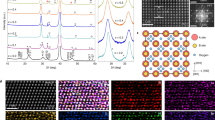Abstract
Capacitors are a mainstay of electronic integrated circuits and devices, where they perform essential functions such as storing electrical charge, and blocking direct current while allowing alternating currents to propagate. Because they are often the largest components in circuits, extensive efforts are directed at reducing their size through the use of high-permittivity insulators such as perovskite-structure SrTiO3 (refs 1, 2), which should provide more capacitance per unit area of device. Unfortunately, most experiments on thin-film SrTiO3 capacitors have yielded capacitance values that are orders of magnitude smaller than expected3. The microscopic origin of this reduced capacitance, which is often discussed in terms of a low-permittivity interfacial ‘dead layer’4, is not well understood. Whether such a dead layer exists at all, and if so, whether it is an intrinsic property of an ideal metal–insulator interface or a result of processing issues such as defects and strains, are controversial questions. Here we present fully ab initio calculations of the dielectric properties of realistic SrRuO3/SrTiO3/SrRuO3 nanocapacitors, and show that the observed dramatic capacitance reduction is indeed an intrinsic effect. We demonstrate the existence of a dielectric dead layer by calculating the dielectric profile across the interface and analyse its origin by extracting the ionic and electronic contributions to the electrostatic screening. We establish a correspondence between the dead layer and the hardening of the collective SrTiO3 zone-centre polar modes, and determine the influence of the electrode by repeating our calculations for Pt/SrTiO3/Pt capacitors. Our results provide practical guidelines for minimizing the deleterious effects of the dielectric dead layer in nanoscale devices.
This is a preview of subscription content, access via your institution
Access options
Subscribe to this journal
Receive 51 print issues and online access
$199.00 per year
only $3.90 per issue
Buy this article
- Purchase on Springer Link
- Instant access to full article PDF
Prices may be subject to local taxes which are calculated during checkout



Similar content being viewed by others
References
Scott, J. F. High-dielectric constant thin films for dynamic random access memories (DRAM). Annu. Rev. Mater. Sci. 28, 79–100 (1998)
Nagaraj, B. et al. (Ba,Sr)TiO3 thin films with conducting perovskite electrodes for dynamic random access memory applications. Appl. Phys. Lett. 74, 3194–3196 (1999)
Mead, C. A. Anomalous capacitance of thin dielectric structures. Phys. Rev. Lett. 6, 545–546 (1961)
Zhou, C. & Newns, D. M. Intrinsic dead layer effect and the performance of ferroelectric thin film capacitors. J. Appl. Phys. 82, 3081–3088 (1997)
Sinnamon, L. J., Bowman, R. M. & Gregg, J. M. Investigation of dead-layer thickness in SrRuO3/Ba0.5Sr0.5TiO3/Au thin-film capacitors. Appl. Phys. Lett. 78, 1724–1726 (2001)
Black, C. T. & Welser, J. J. Electric-field penetration into metals: consequences for high-dielectric constant capacitors. IEEE Trans. Electron Devices 46, 776–780 (1999)
Natori, K., Otani, D. & Sano, N. Thickness dependence of the effective dielectric constant in a thin film capacitor. Appl. Phys. Lett. 73, 632–634 (1998)
Saad, M. M. et al. Intrinsic dielectric response in ferroelectric nano-capacitors. J. Phys. Condens. Matter 16, L451–L456 (2004)
Sinnamon, L. J., Saad, M. M., Bowman, R. M. & Gregg, J. M. Exploring grain size as a cause for “dead-layer” effects in thin film capacitors. Appl. Phys. Lett. 81, 703–705 (2002)
Plonka, R., Dittmann, R., Pertsev, N. A., Vasco, E. & Waser, R. Impact of the top-electrode material on the permittivity of single-crystalline Ba0.7Sr0.3TiO3 thin films. Appl. Phys. Lett. 86, 202908 (2005)
Dawber, M. & Scott, J. F. Models of electrode-dielectric interfaces in ferroelectric thin-film devices. Jpn. J. Appl. Phys. 41, 6848–6851 (2002)
Vendik, O. G., Zubko, S. P. & Ter-Martirosayn, L. T. Experimental evidence of the size effect in thin ferroelectric films. Appl. Phys. Lett. 73, 37–39 (1998)
Sirenko, A. A. et al. Soft-mode hardening in SrTiO3 thin films. Nature 404, 373–376 (2000)
Finnis, M. W. The theory of metal-ceramic interfaces. J. Phys. Condens. Matter 8, 5811–5836 (1996)
Stengel, M. & Spaldin, N. A. Ab-initio theory of metal-insulator interfaces in a finite electric field. Preprint at http://www.arXiv.org/cond-mat/0511042 (2005).
Antons, A., Neaton, J. B., Rabe, K. M. & Vanderbilt, D. Tunability of the dielectric response of epitaxially strained SrTiO3 from first-principles. Phys. Rev. B 71, 024102 (2005)
Blöchl, P. E. Projector augmented-wave method. Phys. Rev. B 50, 17953–17979 (1994)
Junquera, J., Zimmer, M., Ordejón, P. & Ghosez, Ph. First-principles calculation of the band offset at BaO/BaTiO3 and SrO/SrTiO3 interfaces. Phys. Rev B 67, 155325 (2003)
Baroni, S., de Gironcoli, S. & Corso, A. D. Phonons and related crystal properties from density-functional perturbation theory. Rev. Mod. Phys. 73, 515–562 (2001)
Baldereschi, A., Baroni, S. & Resta, R. Band offsets in lattice-matched heterojunctions: a model and first-principles calculations for GaAs/AlAs. Phys. Rev. B 61, 734–737 (1988)
Giustino, F. & Pasquarello, A. Theory of atomic-scale dielectric permittivity at insulator interfaces. Phys. Rev. B 71, 144104 (2005)
Junquera, J. & Ghosez, Ph. Critical thickness for ferroelectricity in perovskite ultrathin films. Nature 422, 506–509 (2003)
Spaldin, N. A. Fundamental size limits in ferroelectricity. Science 304, 1606–1607 (2004)
Fong, D. D. et al. Ferroelectricity in ultrathin perovskite films. Science 304, 1650–1653 (2004)
Ghosez, Ph. & Junquera, J. in Handbook of Theoretical and Computational Nanotechnology (eds Rieth, M. & Schommers, W.) (American Scientific Publisher, Stevenson Ranch, California, 2006)
Hwang, C. S. Thickness-dependent dielectric constants of (Ba,Sr)TiO3 thin films with Pt or conducting oxide electrodes. J. Appl. Phys. 92, 432–437 (2002)
Gerra, G., Tagantsev, A. K., Setter, N. & Parlinski, K. Ionic polarizability of conductive metal oxides and critical thickness for ferroelectricity in BaTiO3 . Phys. Rev. Lett. 96, 107603 (2006)
Kim, D. J. et al. Polarization relaxation induced by a depolarization field in ultrathin ferroelectric BaTiO3 capacitors. Phys. Rev. Lett. 95, 237602 (2005)
Sai, N., Kolpak, A. M. & Rappe, A. M. Ferroelectricity in ultrathin perovskite films. Phys. Rev. B 72, 020101(R) (2005)
Acknowledgements
We thank A. De Vita, Ph. Ghosez, J. Junquera, R. Ramesh, R. Seshadri, J. F. Scott and S. Stemmer for discussions. This work was supported by the National Science Foundation's Division of Materials Research, through the Condensed Matter and Materials Theory Program; computations were performed on the DataStar machine at the San Diego Supercomputer Center.
Author information
Authors and Affiliations
Corresponding author
Ethics declarations
Competing interests
Reprints and permissions information is available at www.nature.com/reprints. The authors declare no competing financial interests.
Rights and permissions
About this article
Cite this article
Stengel, M., Spaldin, N. Origin of the dielectric dead layer in nanoscale capacitors. Nature 443, 679–682 (2006). https://doi.org/10.1038/nature05148
Received:
Accepted:
Issue Date:
DOI: https://doi.org/10.1038/nature05148
This article is cited by
-
Room-temperature ferroelectricity in van der Waals SnP2S6
Frontiers of Physics (2024)
-
Wafer-scale high-κ dielectrics for two-dimensional circuits via van der Waals integration
Nature Communications (2023)
-
Vertically grown ultrathin Bi2SiO5 as high-κ single-crystalline gate dielectric
Nature Communications (2023)
-
Single-crystalline van der Waals layered dielectric with high dielectric constant
Nature Materials (2023)
-
Towards two-dimensional van der Waals ferroelectrics
Nature Materials (2023)
Comments
By submitting a comment you agree to abide by our Terms and Community Guidelines. If you find something abusive or that does not comply with our terms or guidelines please flag it as inappropriate.



